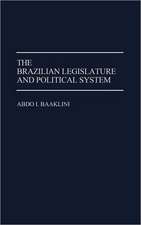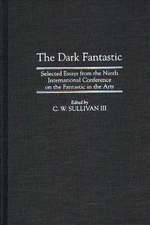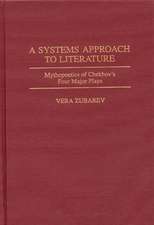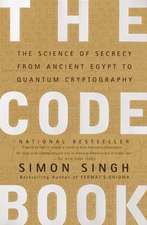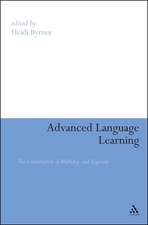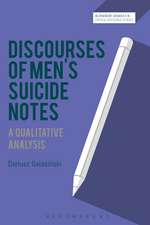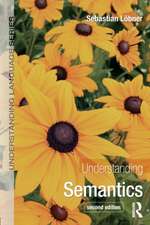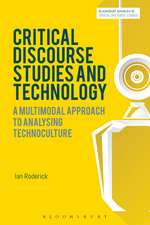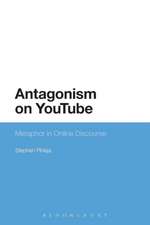New Trends in Corpora and Language Learning: Corpus and Discourse
Editat de Ana Frankenberg-Garcia, Prof Guy Aston, Dr Lynne Flowerdewen Limba Engleză Hardback – 19 ian 2011
| Toate formatele și edițiile | Preț | Express |
|---|---|---|
| Paperback (1) | 258.77 lei 6-8 săpt. | |
| Bloomsbury Publishing – 23 sep 2012 | 258.77 lei 6-8 săpt. | |
| Hardback (1) | 1009.24 lei 6-8 săpt. | |
| Bloomsbury Publishing – 19 ian 2011 | 1009.24 lei 6-8 săpt. |
Din seria Corpus and Discourse
-
 Preț: 179.36 lei
Preț: 179.36 lei -
 Preț: 169.35 lei
Preț: 169.35 lei -
 Preț: 168.91 lei
Preț: 168.91 lei - 23%
 Preț: 197.86 lei
Preț: 197.86 lei - 13%
 Preț: 229.59 lei
Preț: 229.59 lei - 13%
 Preț: 257.50 lei
Preț: 257.50 lei - 22%
 Preț: 1064.84 lei
Preț: 1064.84 lei - 23%
 Preț: 199.03 lei
Preț: 199.03 lei - 18%
 Preț: 304.94 lei
Preț: 304.94 lei - 14%
 Preț: 1008.59 lei
Preț: 1008.59 lei - 13%
 Preț: 257.59 lei
Preț: 257.59 lei - 22%
 Preț: 258.24 lei
Preț: 258.24 lei - 22%
 Preț: 224.29 lei
Preț: 224.29 lei - 22%
 Preț: 258.15 lei
Preț: 258.15 lei - 21%
 Preț: 218.91 lei
Preț: 218.91 lei - 30%
 Preț: 570.76 lei
Preț: 570.76 lei - 19%
 Preț: 495.61 lei
Preț: 495.61 lei - 11%
 Preț: 375.61 lei
Preț: 375.61 lei - 8%
 Preț: 299.86 lei
Preț: 299.86 lei - 19%
 Preț: 344.75 lei
Preț: 344.75 lei - 22%
 Preț: 257.68 lei
Preț: 257.68 lei - 13%
 Preț: 257.97 lei
Preț: 257.97 lei - 22%
 Preț: 258.42 lei
Preț: 258.42 lei - 22%
 Preț: 258.77 lei
Preț: 258.77 lei - 28%
 Preț: 374.34 lei
Preț: 374.34 lei - 14%
 Preț: 570.02 lei
Preț: 570.02 lei - 30%
 Preț: 569.13 lei
Preț: 569.13 lei - 22%
 Preț: 1125.24 lei
Preț: 1125.24 lei - 14%
 Preț: 298.74 lei
Preț: 298.74 lei - 22%
 Preț: 1008.01 lei
Preț: 1008.01 lei
Preț: 1009.24 lei
Preț vechi: 1452.99 lei
-31% Nou
Puncte Express: 1514
Preț estimativ în valută:
193.14€ • 199.53$ • 160.74£
193.14€ • 199.53$ • 160.74£
Carte tipărită la comandă
Livrare economică 26 martie-09 aprilie
Preluare comenzi: 021 569.72.76
Specificații
ISBN-13: 9781441159960
ISBN-10: 1441159967
Pagini: 304
Ilustrații: 1
Dimensiuni: 156 x 234 x 28 mm
Greutate: 0.61 kg
Editura: Bloomsbury Publishing
Colecția Continuum
Seria Corpus and Discourse
Locul publicării:London, United Kingdom
ISBN-10: 1441159967
Pagini: 304
Ilustrații: 1
Dimensiuni: 156 x 234 x 28 mm
Greutate: 0.61 kg
Editura: Bloomsbury Publishing
Colecția Continuum
Seria Corpus and Discourse
Locul publicării:London, United Kingdom
Caracteristici
An analysis of cutting-edge tools for both research and language learning purposes
Notă biografică
Guy Aston is Professor of English Language and Translation, University of Bologna, Italy.
Lynne Flowerdew is a Senior Lecturer at Hong Kong University of Science and Technology, China.
Cuprins
IntroductionPreface by Lou Burnard Part I. Corpora with Language Learners 1. TALC in action: recent innovations in corpus-based English language teaching in Japan Yukio Tono 2. Using a corpus to teach rhetorical functions: students' evaluation of a hands-on concordancing approach Maggie Charles 3. Tracing the Emo side of life: using a corpus of an alternative youth culture discourse to teach cultural studies Bernhard Kettemann 4. Working with different corpora in translation teaching Natalie Kübler 5. A guided collaboration tool for online concordancing with EAP learners Przemyslaw Kaszubski Part II. Corpora for Language Learners 6. A corpus-based approach to automatic feedback for learners' miscollocations Anne Li-E Liu, David Wible and Nai-Lung Tsao 7. Multimodal functional-notional concordancing Francesca Coccetta 8. Academic language and corpus integration in context-based MT Alejandro Curado Fuentes 9. Using Corpora in the Learning and Teaching of Phraseological Variation Martin Warren 10. The SACODEYL search tool: exploiting corpora for language learning purposes Johannes Widmann, Kurt Kohn and Ramon Ziai Part III. Corpora by Language Learners: Learner Language 11. Oral learner corpora and assessment of speaking skills John Osborne 12. Positive and negative evaluation in native and learner speech Sylvie De Cock 13. BAWE: an introduction to a new resource Hilary Nesi 14. Exploring the marking of stance in argumentative essays written by EFL learners and native speakers of English Anna-Maria Hatzitheodorou and Marina Mattheoudakis 15. Polishing papers for publication: palimpsests or procrustean beds? John McKenny and Karen Bennett Bibliography Index
Recenzii
"In this collection we see how corpora can bring benefits to students in such diverse areas as translation studies, academic writing and general language education. The chapters also remind us of how valuable it is to use corpus tools to investigate learner language and - centrally - of how and why one might put the tools for investigating language corpora into the hands of learners themselves. This is essential reading for language teachers and researchers with an interest in the direction of travel of corpus applications in language education. The volume helps us to understand where we have come from and points out those areas where we are likely to see the most value in future work in the investigation and use of corpus data in foreign language teaching and learning."
Whether a reader's interest is classroom pedagogy or software developments, this comprehensive text on new trends in the field will certainly be of value. Importantly, this volume will appeal to a wide audience as it offers plenty to interest those familiar with corpus approaches while remaining accessible to those new to the area.
Whether a reader's interest is classroom pedagogy or software developments, this comprehensive text on new trends in the field will certainly be of value. Importantly, this volume will appeal to a wide audience as it offers plenty to interest those familiar with corpus approaches while remaining accessible to those new to the area.






